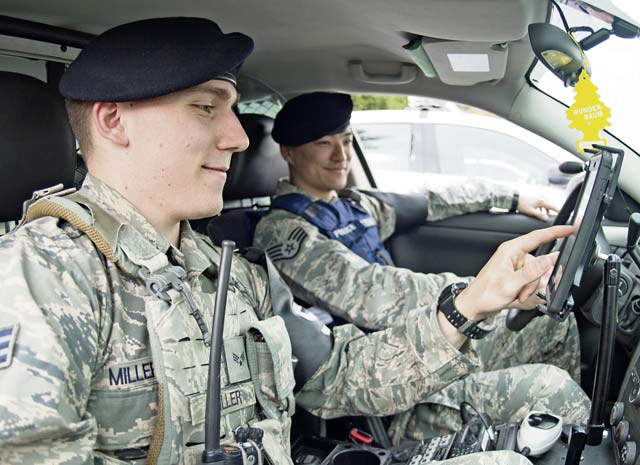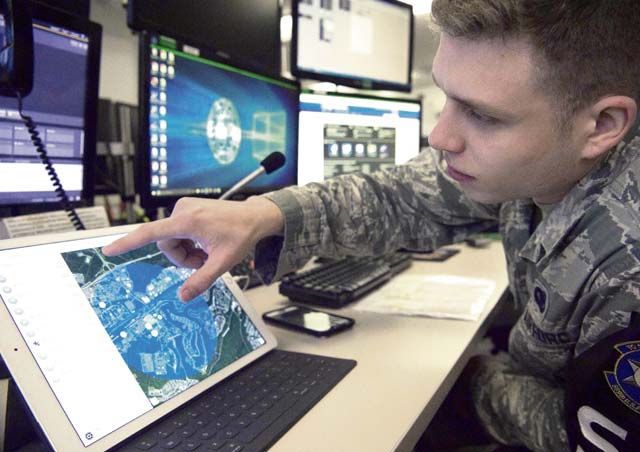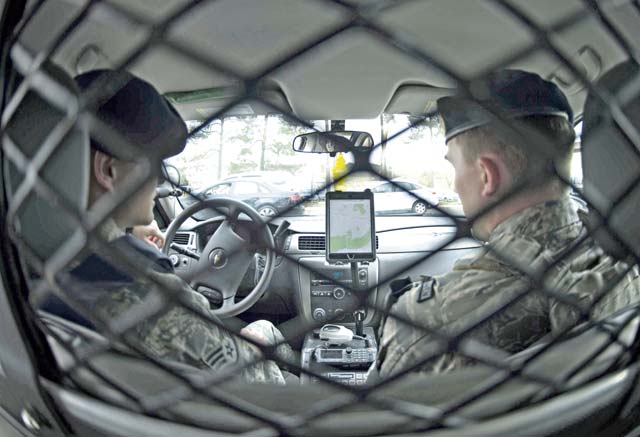
Innovation drives today’s Air Force, and the 569th United States Forces Police Squadron is doing it right. Instead of spending $1.2 million to cut response time with a computer aided dispatching system, the 569th USFPS has figured out how to get the same effect for $10,000, and it’s helping them save lives as well as time and money.
Tech. Sgt. Swen Swearingen, 569th USFPS noncommissioned officer in charge of operations, explained the function of a CAD. When a dispatcher needs to send patrolmen to an incident, a CAD can automatically locate the nearest patrol and notify them, reducing response time.
“In the States, civilian law enforcement agencies use CADs,” Swearingen said. “They’re extremely expensive and hard to get overseas. We figured, ‘Why not use what technology we have available to do the same thing?’”
By using their own version of a CAD, the 569th USFPS estimates it is saving 369 man-hours per fiscal year.
The innovation began when Maj. John-Paul Adrian, who was then a captain serving as 569th USFPS operations officer, figured out how to use tablets and three free tablet applications to do the work of a CAD. Following Adrian’s design, the dispatcher and each patrolman keeps a tablet. A satellite tracking application indicates each patrolman’s location with moving icons on a map. A satellite navigation application provides directions, avoids traffic, and shows an estimated time of arrival to the incident. The third application is a messaging system, which personnel can use to communicate through text, voice, and video.
“Not only do the tablets reduce our response time, they also help get important information from the patrol to the unit,” Swearingen said. “For example, let’s say someone is involved in a major vehicle accident. We’ll use the tablet to get the address to the patrol, and then when they get out there, they can use the cameras on the tablets to get preliminary pictures of the accident scene. Since our tablets work just like cell phones, sometimes we use them for voice and video communication. We’re able to get pictures back to the desk sergeant and he can send them to the First Sergeant.
Swearingen recalled times when the new system was particularly useful.
“The one that jumps out the most is when we had a suicidal teenager who took off,” Swearingen said. “We didn’t know where she was.”
The 569th USFPS began tracking the young woman down. They sent four responders to four possible locations, and one of them found her within two hours. The patrol immediately pinned her location and sent it out to the other patrols as well as to the Red Cross, and they all responded directly to where she was.
“Another time, there was suicidal mother and no one knew where she was,” Swearingen said. “Her daughter had mentioned that when she had alone time she liked to go on hiking trails. A patrol went to a hiking trail outside their city, got out of the car and took the tablet with him. He found her on the trail in the middle of the woods. We were able to get to her and saved her life. That was when I understood how much employing this system helps us.”
Swearingen said he thinks there are a lot of innovations sitting under Airmen’s noses, and that they just have to put in some extra thought and attention to find them.
“I think the younger generation is helping us because they’ve had technology in their hands much more than some of the older NCOs and officers,” Swearingen said.
Swearingen said that it’s important for the Air Force to keep innovating not only to improve the way they get the job done, but also to save money.
“Money is always tight,” Swearingen said. “No matter how much we have, we could always use more, so we have to find ways to save money.”
Saving money often means that units can give their Airmen newer, better equipment, and that makes for better performance and morale.




